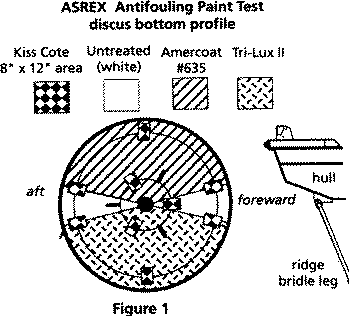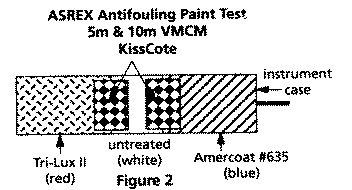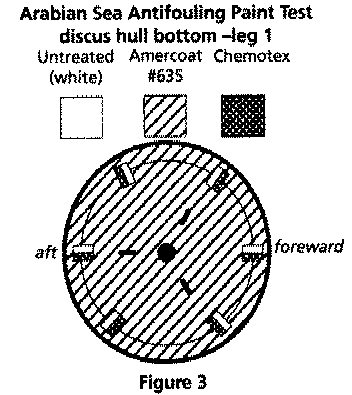

Surface buoys used by the Buoy Group from early 1960 to 1980 were largely fabricated from either fiberglass or steel. The antifouling paint used to protect these buoys from marine fouling was a copper based vinyl antifoulant, manufactured by Woolsey #734. Typically this coating had good antifouling characteristics for immersion periods of up to eight months.
In 1980 the WHOI Buoy Group began using aluminum discus shaped hulls as the primary surface floatation for their deep ocean surface moorings. Several of the aluminum discus hulls were coated with a primer and epoxy top coat followed by two coats of Woolsey #734, each approximately 3 mils (.003") thick. The discus hulls were put into service to support current meter moorings deployed in the Sargasso Sea. After approximately two years of service the primer and top coatings became porous, allowing the copper based antifoulant to come in contact with the aluminum hulls. As a result the discus buoy's aluminum hull became severely pitted from electrolysis between the copper in the antifoulant and the aluminum hull. An alternative antifouling coating that would minimize the bio-fouling and not turn the hull into a battery was sought.
In 1989 the discus hull bottoms were sand blasted to remove all the old primer and top coat antifouling paints from the hulls. An instant set isocyanate urethane formulated by Development Associates of Kingston, R.I., was used as the barrier coating to protect the discus buoy hulls from corrosion. The characteristics of this urethane are very similar in flexibility and durability to the coatings used to encapsulate basket ball court playing surfaces.
A tin based ablative antifouling paint, Amercoat #635 formulated by Ameron was selected for testing. This paint reportedly was compatible with aluminum. In 1990 the discus hull used for the Surface Wave Dynamics Experiment (SWADE) was used as the platform to compare the Ameron product with the Woolsey paint. Fifty percent of the discus bottom was coated with Amercoat #635, 25% with Woolsey #734 and the remaining 25% of the discus bottom was left unpainted to act as the control for the test. Following six months of immersion the discus hull was recovered. The Amercoat #635 had the least amount of fouling, i.e. fewer gooseneck barnacles on the Ameron painted surfaces than on the Woolsey painted areas and control areas. As a result, the Amercoat #635 was the antifoulant of choice by the UOP group for all aluminum discus hull bottoms and sub-surface instrument housings. In 1991 the Amercoat #635 antifouling paint became a Federally regulated substance which restricted its application and use. It had been determined that the paint was harmful to some non-targeted species of fish and shellfish.

Figure 1: The ASREX Antifouling Paint Test- discus bottom.
During the Acoustic Reverberation experiment (ASREX) which took place from October 1993, to April 1994, a UOP discus mooring was deployed in the vicinity of the Gulf Stream. Several alternative antifouling coatings were tested on the discus hull's bottom and sub-surface instrumentation. Three antifouling coatings applied to the ASREX surface buoy hull and sub surface instrumentation were compared. The three coatings that were tested included: Amercoat #635; Interlux TriLux II, a low copper thiocyanate ablative, chosen because it was a non-regulated paint and reportedly did not interact electrochemically in sea water with aluminum; and KissCote, a non-toxic silicon based polymer which uses silicon to minimize the attachment of marine growth. Figure 1 and figure 2 illustrate how the discus bottom and the near surface instrumentation respectively were antifouled with the test coatings.

Figure 2: The ASREX Antifouling Paint Test- 5m & 10m VMCMs.
Following the ASREX mooring recovery, the initial observations showed that the Amercoat #635 out performed the other two coatings. It was concluded that the TriLux II and Kiss Cote had failed due to the relatively low current velocity past the mooring which reduced the effectiveness of the coatings to ablate and keep the test surfaces clean. When these coatings are used on ship hulls the water velocity past the hulls is typically greater than that observed past a moored buoy.

Figure 3: The Arabian Sea Antifouling Paint Test- discus hull bottom.
In 1994 the UOP group deployed a discus buoy surface mooring in the Arabian Sea for a duration of six months. The discus buoy hull was again used as a test platform to compare antifouling paints. For this deployment the buoy hull was painted with three coats of Amercoat #635, each coat approximately 3 mils thick. There were also six (16" x 16") test patches positioned around the chine of the buoy, as shown in figure 3 . Each test patch had two sections. One half was unpainted and was used as a control surface while the other half had a nontoxic anti-corrosive underwater bridge paint called Chemotex, which was developed by CPC Corp. of Wallingford, CT. Chemotex is a calcium sulfonate based paint that the formulators found to work well as an ablative antifoulant. Field immersion tests1 done in Woods Hole found that this coating seemed to minimize the growth of barnacles.
The first Arabian Sea discus buoy was recovered in April 1995. The Amercoat #635 had prevented biofouling only where there had been good water circulation around the hull. Areas on the hull and rigid bridle that had a thin coating (less the 8 mils) had prolific barnacle colonies. The Chemotex coating had completely washed away and slight biofouling growth was evident on the test patches. The control test patches faired as well as the Chemotex with only slight fouling.
A second discus buoy was deployed at the same location for an additional six months beginning in April 1995. The buoy hull was again coated with Amercoat #635. The coating thickness was approximately 16 mils, which was double the thickness on the first Arabian Sea hull. It is hoped that by increasing the thickness of the coating it will have a longer ablative life. The Chemotex coating and an additional antifouling coating called No Foul, formulated by E Paint Co. of Falmouth, MA, were applied to six test patches around the chine of the discus. No Foul is a zinc oxide epoxy base paint. The performance of these coatings will not be known until October 1995 when the second Arabian Sea mooring is scheduled for recovery.
Coating performance is dependent on many variables including time of year, water temperature, location, and deployment duration. We continue to experiment with different coatings in a variety of environments so as to build upon our existing data base. This work is part of a long term test program that continues to field test antifouling coatings for surface buoys and near surface instrumentation.
[1] Scott M. Gallager, Woods Hole Oceanographic Institution. Pilot Study of the Effectiveness of Chemotex, p.2.
 Return to UOP Homepage
Return to UOP Homepage